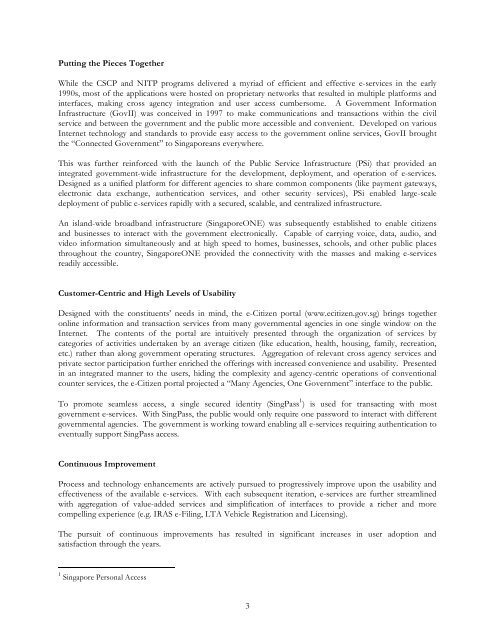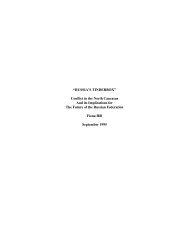Foundation of Effective E-Government ? The Singapore Experience ...
Foundation of Effective E-Government ? The Singapore Experience ...
Foundation of Effective E-Government ? The Singapore Experience ...
You also want an ePaper? Increase the reach of your titles
YUMPU automatically turns print PDFs into web optimized ePapers that Google loves.
Putting the Pieces Together<br />
While the CSCP and NITP programs delivered a myriad <strong>of</strong> efficient and effective e-services in the early<br />
1990s, most <strong>of</strong> the applications were hosted on proprietary networks that resulted in multiple platforms and<br />
interfaces, making cross agency integration and user access cumbersome. A <strong>Government</strong> Information<br />
Infrastructure (GovII) was conceived in 1997 to make communications and transactions within the civil<br />
service and between the government and the public more accessible and convenient. Developed on various<br />
Internet technology and standards to provide easy access to the government online services, GovII brought<br />
the “Connected <strong>Government</strong>” to <strong>Singapore</strong>ans everywhere.<br />
This was further reinforced with the launch <strong>of</strong> the Public Service Infrastructure (PSi) that provided an<br />
integrated government-wide infrastructure for the development, deployment, and operation <strong>of</strong> e-services.<br />
Designed as a unified platform for different agencies to share common components (like payment gateways,<br />
electronic data exchange, authentication services, and other security services), PSi enabled large-scale<br />
deployment <strong>of</strong> public e-services rapidly with a secured, scalable, and centralized infrastructure.<br />
An island-wide broadband infrastructure (<strong>Singapore</strong>ONE) was subsequently established to enable citizens<br />
and businesses to interact with the government electronically. Capable <strong>of</strong> carrying voice, data, audio, and<br />
video information simultaneously and at high speed to homes, businesses, schools, and other public places<br />
throughout the country, <strong>Singapore</strong>ONE provided the connectivity with the masses and making e-services<br />
readily accessible.<br />
Customer-Centric and High Levels <strong>of</strong> Usability<br />
Designed with the constituents’ needs in mind, the e-Citizen portal (www.ecitizen.gov.sg) brings together<br />
online information and transaction services from many governmental agencies in one single window on the<br />
Internet. <strong>The</strong> contents <strong>of</strong> the portal are intuitively presented through the organization <strong>of</strong> services by<br />
categories <strong>of</strong> activities undertaken by an average citizen (like education, health, housing, family, recreation,<br />
etc.) rather than along government operating structures. Aggregation <strong>of</strong> relevant cross agency services and<br />
private sector participation further enriched the <strong>of</strong>ferings with increased convenience and usability. Presented<br />
in an integrated manner to the users, hiding the complexity and agency-centric operations <strong>of</strong> conventional<br />
counter services, the e-Citizen portal projected a “Many Agencies, One <strong>Government</strong>” interface to the public.<br />
To promote seamless access, a single secured identity (SingPass 1 ) is used for transacting with most<br />
government e-services. With SingPass, the public would only require one password to interact with different<br />
governmental agencies. <strong>The</strong> government is working toward enabling all e-services requiring authentication to<br />
eventually support SingPass access.<br />
Continuous Improvement<br />
Process and technology enhancements are actively pursued to progressively improve upon the usability and<br />
effectiveness <strong>of</strong> the available e-services. With each subsequent iteration, e-services are further streamlined<br />
with aggregation <strong>of</strong> value-added services and simplification <strong>of</strong> interfaces to provide a richer and more<br />
compelling experience (e.g. IRAS e-Filing, LTA Vehicle Registration and Licensing).<br />
<strong>The</strong> pursuit <strong>of</strong> continuous improvements has resulted in significant increases in user adoption and<br />
satisfaction through the years.<br />
1 <strong>Singapore</strong> Personal Access<br />
3
















